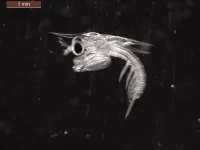Mantis shrimp larvae punch just like Ma and Pa
2021-04-29
(Press-News.org) Adult mantis shrimp pack an explosive punch that can split water, but no crustacean emerges fully formed. Minute larvae can undergo six or seven transformations before emerging as fully developed adults and limbs and manoeuvres develop over time. So, when do mantis shrimp larvae acquire the ability to pulverise their dinner and how powerful are the punches that these mini crustaceans pack? 'We knew that larval mantis shrimp have these beautiful appendages; Megan Porter and Eve Robinson at the University of Hawaii had captured normal videos of a couple of strikes a few years ago', says Jacob Harrison from Duke University, USA. So, he packed up Sheila Patek's high-speed camera and high-resolution lens and travelled to Hawai'i to investigate the developing crustacean's manoeuvres. The team publish their discovery that minute mantis shrimp larvae can begin unleashing their ballistic blows as little as 9-days after hatching in Journal of Experimental Biology at https://journals.biologists.com/jeb, and show that the limbs reach blistering accelerations of 22 million deg/s2, moving at ~0.385mm/s, which is 5-10 times faster than the larval snacks they dine on
'The larvae can be incredibly tricky to collect', says Harrison, recalling how he and Porter lured the microscopic creatures into their nets at night with lights. The problem was that the crustaceans came along with a Noah's ark of other larval critters. 'It can be incredibly challenging to sift through a bucket teeming with larval crabs, shrimp, fish and worms to find the mantis shrimp', laughs Harrison. He then needed a technique for securing the Gonodactylaceus falcatus larvae in place for the camera. 'I had to superglue a 4 mm sized larva onto a toothpick, place it on a custom-designed rig and orient the individual within view of the camera lens before I could even start collecting data. It took about a year to troubleshoot the right way to set up the camera before we knew that we could capture these videos', Harrison recalls.
Analysing the high-speed movies, Harrison, Patek and Matt McHenry (University of California, Irvine, USA) could see a region on the first portion of the appendage bending to store energy - like a spring - as the larvae wound in the club-like limb ready for a flick. Then, the larvae released an internal latch that had held the appendage in place, releasing the stored energy and catapulting the limb into action. In fact, the larvae's appendage and the way it operates is remarkably similar to that in the adults, just scaled down. Most excitingly, the team realised that they could see the minute muscles within the larvae's glassy bodies contracting as they bowed the exoskeleton, something that could only be imagined in adult mantis shrimp: 'We were amazed', Harrison says.
But when did the minute larvae develop their ability to annihilate prey with a single blow? Venturing off the Hawaiian shore, Harrison located an egg-laden female and retrieved her mat of eggs, but by the time they arrived at Duke University, the eggs had hatched. 'We weren't sure we could keep the larvae alive in the lab', Harrison recalls. However, he nurtured the youngsters patiently until they developed successfully to 28-day old larvae and discovered that the limb only became fully operational when the youngsters began feeding, at around 9-15days. It also turned out that the larvae could hurl the limb at rotational speeds of ~16,500deg/s, with eyewatering accelerations as fast as the adults. However, their smaller stature meant that the limb moved at ~0.385m/s, which is slower than the adults, but still quite speedy for a 4.2mm long creature. Even at their smallest, there is no escaping these spring-powered predators.
INFORMATION:
IF REPORTING THIS STORY, PLEASE MENTION JOURNAL OF EXPERIMENTAL BIOLOGY AS THE SOURCE AND, IF REPORTING ONLINE, PLEASE CARRY A LINK TO: https://journals.biologists.com/jeb/article-lookup/224/8/jeb235465
REFERENCE: Harrison, J. S., Porter, M. L., McHenry, M. J., Robinson, H. E. and Patek, S. N. (2021). Scaling and development of elastic mechanisms: the tiny strikes of larval mantis shrimp. J. Exp. Biol. 224, jeb235465.
DOI:10.1242/jeb.242590
This article is posted on this site to give advance access to other authorised media who may wish to report on this story. Full attribution is required, and if reporting online a link to jeb.biologists.com is also required. The story posted here is COPYRIGHTED. Therefore advance permission is required before any and every reproduction of each article in full. PLEASE CONTACT permissions@biologists.com
[Attachments] See images for this press release:

ELSE PRESS RELEASES FROM THIS DATE:
2021-04-29
Adult heterosexual women and men are often jealous about completely different threats to their relationship. These differences seem to establish themselves far sooner than people need them. The finding surprised researchers at the Norwegian University of Science and Technology (NTNU) who studied the topic.
"You don't really need this jealousy until you need to protect yourself from being deceived," says Professor Leif Edward Ottesen Kennair at NTNU's Department of Psychology.
Romantic jealousy can be experienced as horrible at its worst. But jealousy associated with a partner's infidelity has clearly been ...
2021-04-29
More than a quarter of American infants in 2018 had not received common childhood vaccines that protect them from illnesses such as polio, tetanus, measles, mumps and chicken pox, new research from the University of Virginia School of Medicine reveals.
Only 72.8% of infants aged 19-35 months had received the full series of the seven recommended vaccines, falling far short of the federal government's goal of 90%. Those less likely to complete the vaccine series include African-American infants, infants born to mothers with less than a high-school education and infants in families with incomes below the federal poverty line.
The researchers warn that failure to complete the vaccine series leaves children at increased risk of infection, illness and death. It also reduces the herd ...
2021-04-29
Human decision-making depends on the flexible processing of complex information, but how the brain may adapt processing to momentary task demands has remained unclear. In a new article published in the journal Nature Communications, researchers from the Max Planck Institute for Human Development have now outlined several crucial neural processes revealing that our brain networks may rapidly and flexibly shift from a rhythmic to a "noisy" state when the need to process information increases.
Driving a car, deliberating over different financial options, or even pondering different life paths requires us to process an overwhelming amount of information. But not all decisions pose equal demands. In some situations, decisions are easier because we already know which ...
2021-04-29
People with diabetes are at increased risk of developing a severe course of COVID-19 compared to people without diabetes. The question to be answered is whether all people with diabetes have an increased risk of severe COVID-19, or whether specific risk factors can also be identified within this group. A new study by DZD researchers has now focused precisely on this question and gained relevant insights.
The COVID-19 pandemic poses unprecedented challenges to science and the health sector. While in some people with a SARS-CoV-2 infection the disease is hardly noticeable, in others ...
2021-04-29
Exposure before birth to persistent organic pollutants (POPs)-- organochlorine pesticides, industrial chemicals, etc.--may increase the risk in adolescence of metabolic disorders, such as obesity and high blood pressure. This was the main conclusion of a study by the Barcelona Institute for Global Health (ISGlobal), a research centre supported by the "la Caixa" Foundation. The study was based on data from nearly 400 children living in Menorca, who were followed from before birth until they reached 18 years of age.
POPs are toxic, degradation-resistant ...
2021-04-29
A top-level international research team including researchers from the University of Eastern Finland has developed a new algorithm for the diagnostics of dementia. The algorithm is based on blood and cerebrospinal fluid biomarker measurements. These biomarkers can be used to aid setting of an exact diagnosis already in the early phases of dementia.
Researchers from the University of Eastern Finland and the University of Oulu in collaboration with an international team have created a new diagnostic biomarker-based algorithm for the diagnostics of dementia. The team is led by Professor Barbara Borroni from the University of Brescia, Italy. The article was published in the Diagnostics journal.
The accurate diagnosis ...
2021-04-29
The proliferation of electric cars, smartphones, and portable devices is leading to an estimated 25 percent increase globally in the manufacturing of rechargeable batteries each year. Many raw materials used in the batteries, such as cobalt, may soon be in short supply. The European Commission is preparing a new battery decree, which would require the recycling of 95 percent of the cobalt in batteries. Yet existing battery recycling methods are far from perfect.
Researchers at Aalto University have now discovered that electrodes in lithium batteries containing cobalt can be reused as is after being newly saturated with lithium. In comparison to traditional recycling, which typically ...
2021-04-29
Glaciers are a sensitive indicator of climate change - and one that can be easily observed. Regardless of altitude or latitude, glaciers have been melting at a high rate since the mid-?20th century. Until now, however, the full extent of ice loss has only been partially measured and understood. Now an international research team led by ETH Zurich and the University of Toulouse has authored a comprehensive study on global glacier retreat, which was published online in Nature on 28 April. This is the first study to include all the world's glaciers - around 220,000 in total - excluding the Greenland and Antarctic ice sheets. The study's spatial and temporal resolution is unprecedented - and shows how rapidly glaciers have lost thickness and mass over the past two decades.
Rising sea levels ...
2021-04-29
Spreading of the seafloor in the Red Sea basin is found to have begun along its entire length around 13 million years ago, making its underlying oceanic crust twice as old as previously believed.
The formation history and age of the Red Sea basin has long been contested, largely because the crust under the sea is widely overlain by thick layers of salt and sediment, making it difficult to observe directly.
"Existing geological models of the Red Sea often contradict each other, largely due to limited high-resolution data and the influence of overlaying salt layers," says Froukje van der Zwan from KAUST, who worked on the project. "For example, ...
2021-04-29
Lacticaseibacillus rhamnosus GG, or LGG, is the most studied probiotic bacterium in the world. However, its features are not perfect, as it is unable to utilise the milk carbohydrate lactose or break down the milk protein casein. This is why the bacterium grows poorly in milk and why it has to be separately added to probiotic dairy products.
In fact, attempts have been made to make L. rhamnosus GG better adjust to milk through genetic engineering. However, strict restrictions have prevented the use of such modified bacteria in human food.
Thanks to a recent breakthrough made at the University of Helsinki, Finland, with researchers from the National Institute for Biotechnology and Genetic ...
LAST 30 PRESS RELEASES:
[Press-News.org] Mantis shrimp larvae punch just like Ma and Pa



